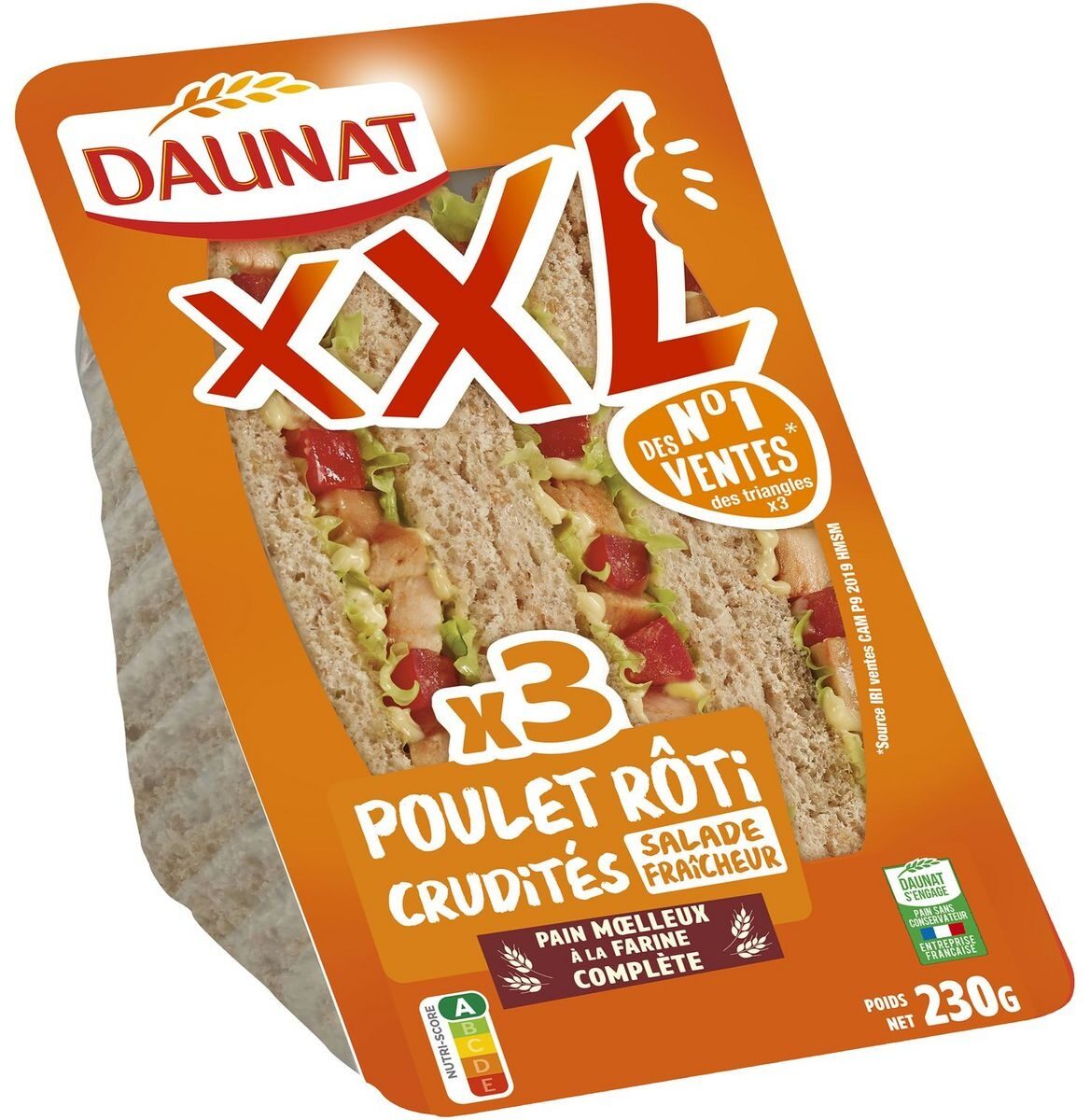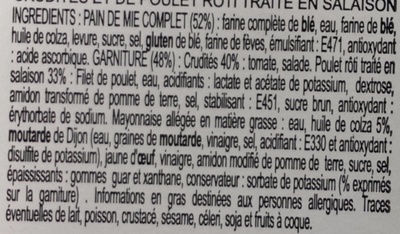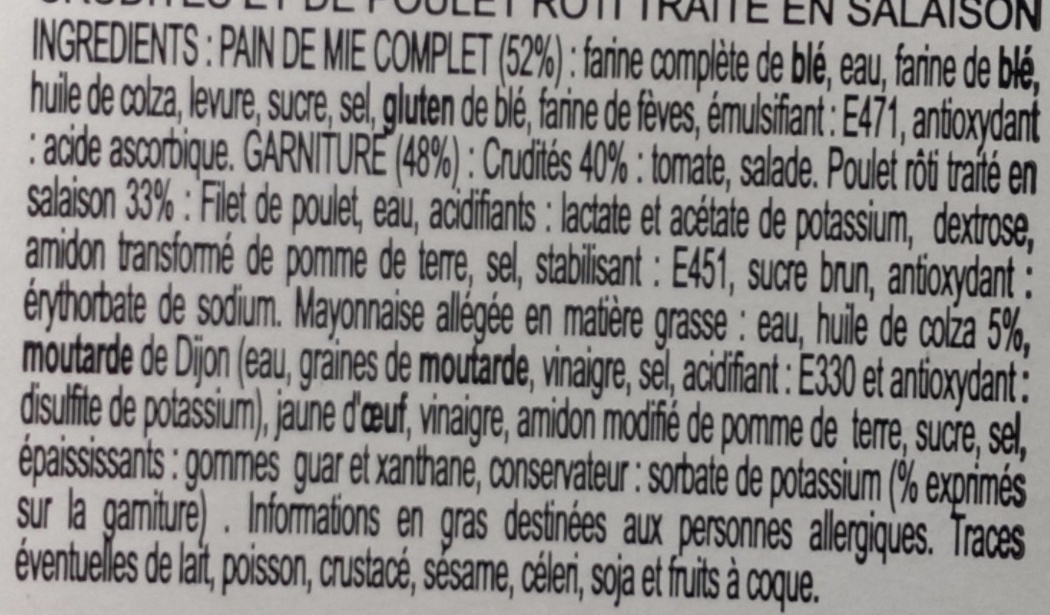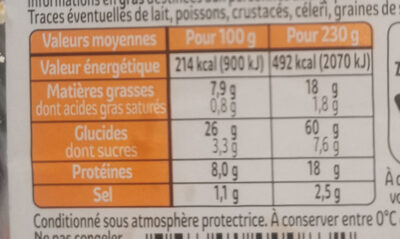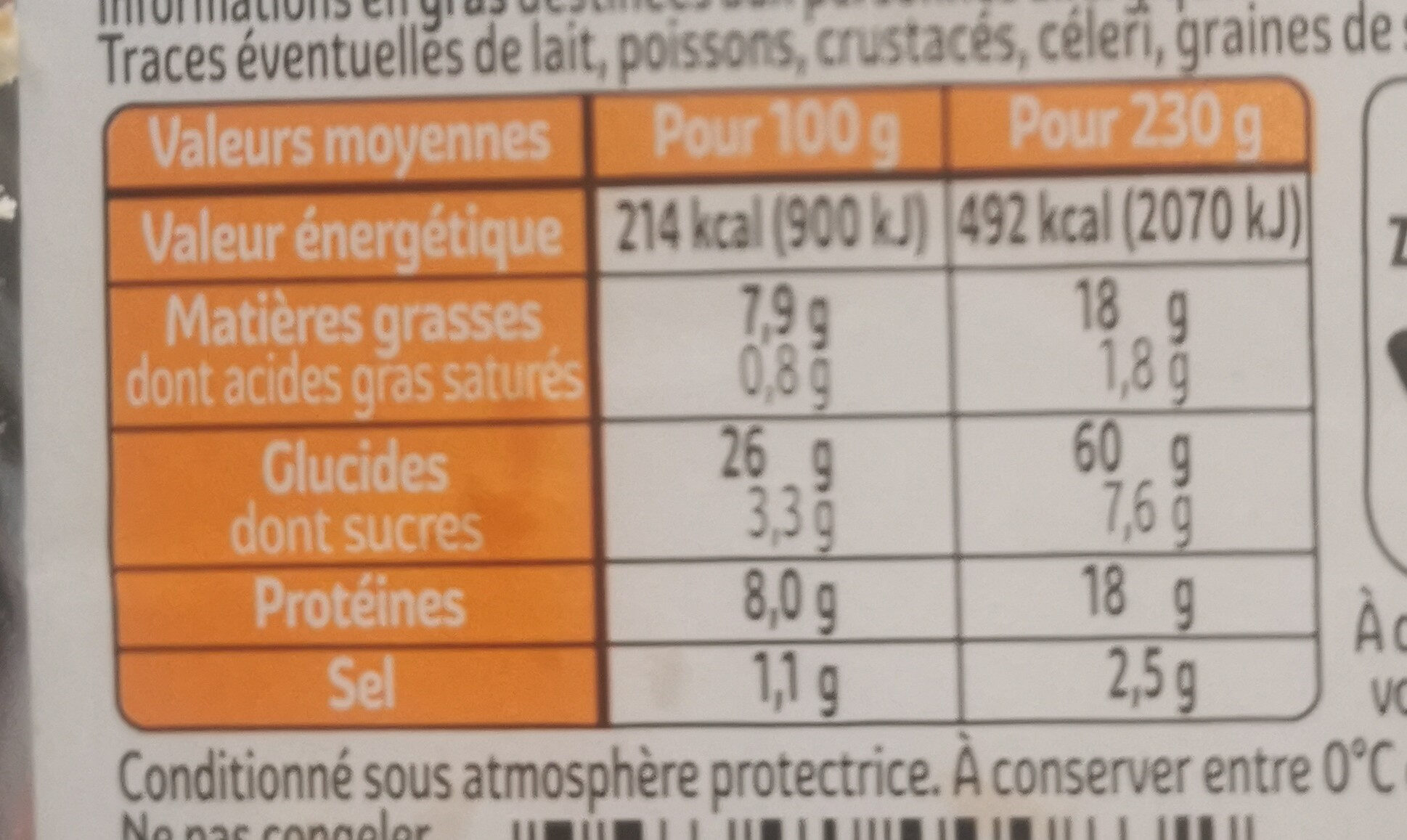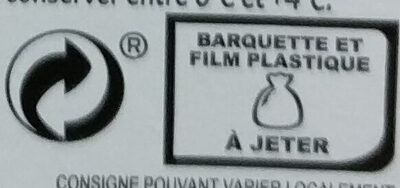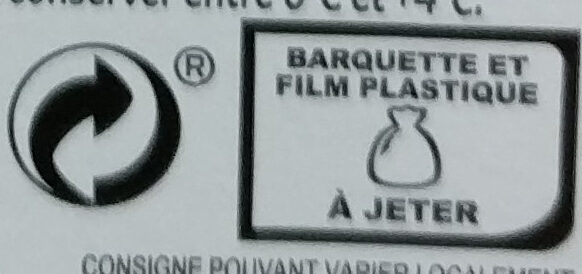Help us make food transparency the norm!
As a non-profit organization, we depend on your donations to continue informing consumers around the world about what they eat.
The food revolution starts with you!
XXL poulet roti crudites - Daunat - 230 g
XXL poulet roti crudites - Daunat - 230 g
This product page is not complete. You can help to complete it by editing it and adding more data from the photos we have, or by taking more photos using the app for Android or iPhone/iPad. Thank you!
×
Barcode: 3367651000832 (EAN / EAN-13)
Common name: Sandwich au pain de mie complet garni de crudités et de poulet rôti traité en salaison
Quantity: 230 g
Packaging: Plastic, Fresh, Tray
Brands: Daunat
Categories: Sandwiches, Poultry sandwiches, Chicken sandwiches, Raw vegetable sandwiches
Labels, certifications, awards:
Green Dot, Made in France, No additives, Nutriscore, Nutriscore Grade A
Manufacturing or processing places: France
Stores: Magasins U, carrefour.fr
Countries where sold: France
Matching with your preferences
Health
Ingredients
-
54 ingredients
: Pain de mie complet (52%) : farine complète de blé, eau, farine de blé, huile de colza, levure, sucre, sel, gluten de blé, farine de fèves, émulsifiant : E471, antioxydant : acide ascorbique. Garniture (48%) : Crudités 40% : tomate, salade. Poulet rôti traité en salaison 33% : filet de poulet, eau, acidifiants : lactate et acétate de potassium, dextrose, amidon transformé de pomme de terre, sel, stabilisant : E451, sucre brun, antioxydant : érythorbate de sodium. Mayonnaise allégée en matière grasse : eau, huile de colza 5%, moutarde de Dijon (eau, graines de moutarde, vinaigre, sel, acidifiant : E330 et antioxydant : disulfite de potassium), jaune d'œuf, vinaigre, amidon modifié de pomme de terre, sucre, sel, épaississants : gommes guar et xanthane, conservateur : sorbate de potassium (% exprimés sur la garniture).Allergens: Eggs, Gluten, MustardTraces: Celery, Crustaceans, Fish, Milk, Nuts, Sesame seeds
Food processing
-
Ultra processed foods
Elements that indicate the product is in the 4 - Ultra processed food and drink products group:
- Additive: E14XX - Modified Starch
- Additive: E412 - Guar gum
- Additive: E415 - Xanthan gum
- Additive: E451 - Triphosphates
- Additive: E471 - Mono- and diglycerides of fatty acids
- Ingredient: Dextrose
- Ingredient: Emulsifier
- Ingredient: Glucose
- Ingredient: Gluten
- Ingredient: Thickener
Food products are classified into 4 groups according to their degree of processing:
- Unprocessed or minimally processed foods
- Processed culinary ingredients
- Processed foods
- Ultra processed foods
The determination of the group is based on the category of the product and on the ingredients it contains.
Additives
-
E202 - Potassium sorbate
Potassium sorbate (E202) is a synthetic food preservative commonly used to extend the shelf life of various food products.
It works by inhibiting the growth of molds, yeast, and some bacteria, preventing spoilage. When added to foods, it helps maintain their freshness and quality.
Some studies have shown that when combined with nitrites, potassium sorbate have genotoxic activity in vitro. However, potassium sorbate is generally recognized as safe (GRAS) by regulatory authorities.
-
E224 - Potassium metabisulphite
Potassium metabisulfite: Potassium metabisulfite, K2S2O5, also known as potassium pyrosulfite, is a white crystalline powder with a pungent sulfur odour. The main use for the chemical is as an antioxidant or chemical sterilant. It is a disulfite and is chemically very similar to sodium metabisulfite, with which it is sometimes used interchangeably. Potassium metabisulfite is generally preferred out of the two as it does not contribute sodium to the diet. Potassium metabisulfite has a monoclinic crystal structure which decomposes at 190 °C, yielding potassium sulfite and sulfur dioxide: K2S2O5-s- → K2SO3-s- + SO2-g-Source: Wikipedia
-
E261 - Potassium acetate
Potassium acetate: Potassium acetate -KCH3COO- is the potassium salt of acetic acid.Source: Wikipedia
-
E270 - Lactic acid
Lactic acid: Lactic acid is an organic compound with the formula CH3CH-OH-COOH. In its solid state, it is white and water-soluble. In its liquid state, it is colorless. It is produced both naturally and synthetically. With a hydroxyl group adjacent to the carboxyl group, lactic acid is classified as an alpha-hydroxy acid -AHA-. In the form of its conjugate base called lactate, it plays a role in several biochemical processes. In solution, it can ionize a proton from the carboxyl group, producing the lactate ion CH3CH-OH-CO−2. Compared to acetic acid, its pKa is 1 unit less, meaning lactic acid deprotonates ten times more easily than acetic acid does. This higher acidity is the consequence of the intramolecular hydrogen bonding between the α-hydroxyl and the carboxylate group. Lactic acid is chiral, consisting of two optical isomers. One is known as L--+--lactic acid or -S--lactic acid and the other, its mirror image, is D--−--lactic acid or -R--lactic acid. A mixture of the two in equal amounts is called DL-lactic acid, or racemic lactic acid. Lactic acid is hygroscopic. DL-lactic acid is miscible with water and with ethanol above its melting point which is around 17 or 18 °C. D-lactic acid and L-lactic acid have a higher melting point. In animals, L-lactate is constantly produced from pyruvate via the enzyme lactate dehydrogenase -LDH- in a process of fermentation during normal metabolism and exercise. It does not increase in concentration until the rate of lactate production exceeds the rate of lactate removal, which is governed by a number of factors, including monocarboxylate transporters, concentration and isoform of LDH, and oxidative capacity of tissues. The concentration of blood lactate is usually 1–2 mM at rest, but can rise to over 20 mM during intense exertion and as high as 25 mM afterward. In addition to other biological roles, L-lactic acid is the primary endogenous agonist of hydroxycarboxylic acid receptor 1 -HCA1-, which is a Gi/o-coupled G protein-coupled receptor -GPCR-.In industry, lactic acid fermentation is performed by lactic acid bacteria, which convert simple carbohydrates such as glucose, sucrose, or galactose to lactic acid. These bacteria can also grow in the mouth; the acid they produce is responsible for the tooth decay known as caries. In medicine, lactate is one of the main components of lactated Ringer's solution and Hartmann's solution. These intravenous fluids consist of sodium and potassium cations along with lactate and chloride anions in solution with distilled water, generally in concentrations isotonic with human blood. It is most commonly used for fluid resuscitation after blood loss due to trauma, surgery, or burns.Source: Wikipedia
-
E316 - Sodium erythorbate
Sodium erythorbate: Sodium erythorbate -C6H7NaO6- is a food additive used predominantly in meats, poultry, and soft drinks. Chemically, it is the sodium salt of erythorbic acid. When used in processed meat such as hot dogs and beef sticks, it increases the rate at which nitrite reduces to nitric oxide, thus facilitating a faster cure and retaining the pink coloring. As an antioxidant structurally related to vitamin C, it helps improve flavor stability and prevents the formation of carcinogenic nitrosamines. When used as a food additive, its E number is E316. The use of erythorbic acid and sodium erythorbate as a food preservative has increased greatly since the U.S. Food and Drug Administration banned the use of sulfites as preservatives in foods intended to be eaten fresh -such as ingredients for fresh salads- and as food processors have responded to the fact that some people are allergic to sulfites. It can also be found in bologna, and is occasionally used in beverages, baked goods, and potato salad.Sodium erythorbate is produced from sugars derived from different sources, such as beets, sugar cane, and corn. An urban myth claims that sodium erythorbate is made from ground earthworms; however, there is no truth to the myth. It is thought that the genesis of the legend comes from the similarity of the chemical name to the words earthworm and bait.Alternative applications include the development of additives that could be utilized as anti-oxidants in general. For instance, this substance has been implemented in the development of corrosion inhibitors for metals and it has been implemented in active packaging.Sodium erythorbate is soluble in water. The pH of the aqueous solution of the sodium salt is between 5 and 6. A 10% solution, made from commercial grade sodium erythorbate, may have a pH of 7.2 to 7.9. In its dry, crystalline state it is nonreactive. But, when in solution with water it readily reacts with atmospheric oxygen and other oxidizing agents, which makes it a valuable antioxidant.Source: Wikipedia
-
E330 - Citric acid
Citric acid is a natural organic acid found in citrus fruits such as lemons, oranges, and limes.
It is widely used in the food industry as a flavor enhancer, acidulant, and preservative due to its tart and refreshing taste.
Citric acid is safe for consumption when used in moderation and is considered a generally recognized as safe (GRAS) food additive by regulatory agencies worldwide.
-
E412 - Guar gum
Guar gum (E412) is a natural food additive derived from guar beans.
This white, odorless powder is valued for its remarkable thickening and stabilizing properties, making it a common ingredient in various food products, including sauces, dressings, and ice creams.
When used in moderation, guar gum is considered safe for consumption, with no known adverse health effects.
-
E415 - Xanthan gum
Xanthan gum (E415) is a natural polysaccharide derived from fermented sugars, often used in the food industry as a thickening and stabilizing agent.
This versatile food additive enhances texture and prevents ingredient separation in a wide range of products, including salad dressings, sauces, and gluten-free baked goods.
It is considered safe for consumption even at high intake amounts.
-
E451 - Triphosphates
Sodium triphosphate: Sodium triphosphate -STP-, also sodium tripolyphosphate -STPP-, or tripolyphosphate -TPP-,- is an inorganic compound with formula Na5P3O10. It is the sodium salt of the polyphosphate penta-anion, which is the conjugate base of triphosphoric acid. It is produced on a large scale as a component of many domestic and industrial products, especially detergents. Environmental problems associated with eutrophication are attributed to its widespread use.Source: Wikipedia
-
E471 - Mono- and diglycerides of fatty acids
Mono- and diglycerides of fatty acids (E471), are food additives commonly used as emulsifiers in various processed foods.
These compounds consist of glycerol molecules linked to one or two fatty acid chains, which help stabilize and blend water and oil-based ingredients. E471 enhances the texture and shelf life of products like margarine, baked goods, and ice cream, ensuring a smooth and consistent texture.
It is generally considered safe for consumption within established regulatory limits.
Ingredients analysis
-
May contain palm oil
Ingredients that may contain palm oil: E471
-
Non-vegan
Non-vegan ingredients: fr:Poulet rôti traité en salaison, Chicken fillet, Egg yolk
-
Non-vegetarian
Non-vegetarian ingredients: fr:Poulet rôti traité en salaison, Chicken fillet
-
Details of the analysis of the ingredients
: Pain de mie complet 52% (farine complète de _blé_), eau, farine de _blé_, huile de colza, levure, sucre, sel, _gluten_ de blé, farine de fèves, émulsifiant (e471), antioxydant (acide ascorbique, Garniture 48%), Crudités 40% (tomate), salade, Poulet rôti traité en salaison 33% (filet de poulet), eau, acidifiants (lactate, acétate de potassium), dextrose, amidon transformé de pomme de terre, sel, stabilisant (e451), sucre brun, antioxydant (érythorbate de sodium, Mayonnaise allégée en matière grasse), eau, huile de colza 5%, _moutarde_ de Dijon (eau, graines de _moutarde_, vinaigre, sel, acidifiant (e330), antioxydant (disulfite de potassium)), jaune d'_œuf_, vinaigre, amidon modifié de pomme de terre, sucre, sel, épaississants (gommes guar, xanthane), conservateur (sorbate de potassium ())- Pain de mie complet -> fr:pain-de-mie-complet - percent: 52
- farine complète de _blé_ -> en:whole-wheat-flour - vegan: yes - vegetarian: yes - ciqual_proxy_food_code: 9410
- eau -> en:water - vegan: yes - vegetarian: yes - ciqual_food_code: 18066
- farine de _blé_ -> en:wheat-flour - vegan: yes - vegetarian: yes - ciqual_proxy_food_code: 9410
- huile de colza -> en:colza-oil - vegan: yes - vegetarian: yes - from_palm_oil: no - ciqual_food_code: 17130
- levure -> en:yeast - vegan: yes - vegetarian: yes
- sucre -> en:sugar - vegan: yes - vegetarian: yes - ciqual_proxy_food_code: 31016
- sel -> en:salt - vegan: yes - vegetarian: yes - ciqual_food_code: 11058
- _gluten_ de blé -> en:wheat-gluten - vegan: yes - vegetarian: yes
- farine de fèves -> en:broad-bean-flour - vegan: yes - vegetarian: yes - ciqual_proxy_food_code: 9410
- émulsifiant -> en:emulsifier
- e471 -> en:e471 - vegan: maybe - vegetarian: maybe - from_palm_oil: maybe
- antioxydant -> en:antioxidant
- acide ascorbique -> en:e300 - vegan: yes - vegetarian: yes
- Garniture -> en:filling - vegan: maybe - vegetarian: maybe - percent: 48
- Crudités -> en:crudites - vegan: yes - vegetarian: yes - percent: 40
- tomate -> en:tomato - vegan: yes - vegetarian: yes - ciqual_food_code: 20047
- salade -> en:salad - vegan: yes - vegetarian: yes
- Poulet rôti traité en salaison -> fr:poulet-roti-traite-en-salaison - vegan: no - vegetarian: no - ciqual_food_code: 36005 - percent: 33
- filet de poulet -> en:chicken-fillet - vegan: no - vegetarian: no - ciqual_food_code: 36018
- eau -> en:water - vegan: yes - vegetarian: yes - ciqual_food_code: 18066
- acidifiants -> en:acid
- lactate -> en:e270 - vegan: yes - vegetarian: yes
- acétate de potassium -> en:e261 - vegan: yes - vegetarian: yes
- dextrose -> en:dextrose - vegan: yes - vegetarian: yes - ciqual_proxy_food_code: 31016
- amidon transformé de pomme de terre -> en:modified-potato-starch - vegan: yes - vegetarian: yes - ciqual_proxy_food_code: 9510
- sel -> en:salt - vegan: yes - vegetarian: yes - ciqual_food_code: 11058
- stabilisant -> en:stabiliser
- e451 -> en:e451 - vegan: yes - vegetarian: yes
- sucre brun -> en:caramelised-sugar - vegan: yes - vegetarian: yes - ciqual_proxy_food_code: 31016
- antioxydant -> en:antioxidant
- érythorbate de sodium -> en:e316 - vegan: yes - vegetarian: yes
- Mayonnaise allégée en matière grasse -> en:reduced-fat-mayonnaise - vegan: maybe - vegetarian: maybe - ciqual_food_code: 11079
- eau -> en:water - vegan: yes - vegetarian: yes - ciqual_food_code: 18066
- huile de colza -> en:colza-oil - vegan: yes - vegetarian: yes - from_palm_oil: no - ciqual_food_code: 17130 - percent: 5
- _moutarde_ de Dijon -> en:dijon-mustard - ciqual_food_code: 11013
- eau -> en:water - vegan: yes - vegetarian: yes - ciqual_food_code: 18066
- graines de _moutarde_ -> en:mustard-seed - vegan: yes - vegetarian: yes - ciqual_food_code: 11013
- vinaigre -> en:vinegar - vegan: yes - vegetarian: yes - ciqual_food_code: 11018
- sel -> en:salt - vegan: yes - vegetarian: yes - ciqual_food_code: 11058
- acidifiant -> en:acid
- e330 -> en:e330 - vegan: yes - vegetarian: yes
- antioxydant -> en:antioxidant
- disulfite de potassium -> en:e224 - vegan: yes - vegetarian: yes
- jaune d'_œuf_ -> en:egg-yolk - vegan: no - vegetarian: yes - ciqual_food_code: 22002
- vinaigre -> en:vinegar - vegan: yes - vegetarian: yes - ciqual_food_code: 11018
- amidon modifié de pomme de terre -> en:modified-potato-starch - vegan: yes - vegetarian: yes - ciqual_proxy_food_code: 9510
- sucre -> en:sugar - vegan: yes - vegetarian: yes - ciqual_proxy_food_code: 31016
- sel -> en:salt - vegan: yes - vegetarian: yes - ciqual_food_code: 11058
- épaississants -> en:thickener
- gommes guar -> en:e412 - vegan: yes - vegetarian: yes
- xanthane -> en:e415 - vegan: yes - vegetarian: yes
- conservateur -> en:preservative
- sorbate de potassium -> en:e202 - vegan: yes - vegetarian: yes
- sorbate de potassium -> en:e202 - vegan: yes - vegetarian: yes
- Pain de mie complet -> fr:pain-de-mie-complet - percent: 52
Nutrition
-
Good nutritional quality
⚠ ️Warning: the amount of fiber is not specified, their possible positive contribution to the grade could not be taken into account.⚠ ️Warning: the amount of fruits, vegetables and nuts is not specified on the label, it was estimated from the list of ingredients: 51This product is not considered a beverage for the calculation of the Nutri-Score.
Positive points: 5
- Proteins: 4 / 5 (value: 8, rounded value: 8)
- Fiber: 0 / 5 (value: 0, rounded value: 0)
- Fruits, vegetables, nuts, and colza/walnut/olive oils: 1 / 5 (value: 51, rounded value: 51)
Negative points: 6
- Energy: 2 / 10 (value: 895, rounded value: 895)
- Sugars: 0 / 10 (value: 3.3, rounded value: 3.3)
- Saturated fat: 0 / 10 (value: 0.8, rounded value: 0.8)
- Sodium: 4 / 10 (value: 440, rounded value: 440)
The points for proteins are counted because the negative points are less than 11.
Nutritional score: (6 - 5)
Nutri-Score:
-
Nutrient levels
-
Fat in moderate quantity (7.9%)
What you need to know- A high consumption of fat, especially saturated fats, can raise cholesterol, which increases the risk of heart diseases.
Recommendation: Limit the consumption of fat and saturated fat- Choose products with lower fat and saturated fat content.
-
Saturated fat in low quantity (0.8%)
What you need to know- A high consumption of fat, especially saturated fats, can raise cholesterol, which increases the risk of heart diseases.
Recommendation: Limit the consumption of fat and saturated fat- Choose products with lower fat and saturated fat content.
-
Sugars in low quantity (3.3%)
What you need to know- A high consumption of sugar can cause weight gain and tooth decay. It also augments the risk of type 2 diabetes and cardio-vascular diseases.
Recommendation: Limit the consumption of sugar and sugary drinks- Sugary drinks (such as sodas, fruit beverages, and fruit juices and nectars) should be limited as much as possible (no more than 1 glass a day).
- Choose products with lower sugar content and reduce the consumption of products with added sugars.
-
Salt in moderate quantity (1.1%)
What you need to know- A high consumption of salt (or sodium) can cause raised blood pressure, which can increase the risk of heart disease and stroke.
- Many people who have high blood pressure do not know it, as there are often no symptoms.
- Most people consume too much salt (on average 9 to 12 grams per day), around twice the recommended maximum level of intake.
Recommendation: Limit the consumption of salt and salted food- Reduce the quantity of salt used when cooking, and don't salt again at the table.
- Limit the consumption of salty snacks and choose products with lower salt content.
-
-
Nutrition facts
Nutrition facts As sold
for 100 g / 100 mlAs sold
per serving (230 g)Compared to: Raw vegetable sandwiches Energy 895 kj
(214 kcal)2,060 kj
(492 kcal)-0% Fat 7.9 g 18.2 g -1% Saturated fat 0.8 g 1.84 g -42% Carbohydrates 26 g 59.8 g +4% Sugars 3.3 g 7.59 g +5% Fiber ? ? Proteins 8 g 18.4 g -13% Salt 1.1 g 2.53 g -6% Fruits‚ vegetables‚ nuts and rapeseed‚ walnut and olive oils (estimate from ingredients list analysis) 51 % 51 % Carbon footprint from meat or fish 161.7 g 372 g
Environment
-
Eco-Score C - Moderate environmental impact
⚠ ️Select a country in order to include the full impact of transportation.The Eco-Score is an experimental score that summarizes the environmental impacts of food products.→ The Eco-Score was initially developped for France and it is being extended to other European countries. The Eco-Score formula is subject to change as it is regularly improved to make it more precise and better suited to each country.Life cycle analysis
-
Average impact of products of the same category: C (Score: 56/100)
Category: Sandwich made with wholemeal loaf bread, chicken, raw vegetables and mayonnaise
Category: Sandwich made with wholemeal loaf bread, chicken, raw vegetables and mayonnaise
- PEF environmental score: 0.47 (the lower the score, the lower the impact)
- including impact on climate change: 3.51 kg CO2 eq/kg of product
Stage Impact Agriculture
73.0 %Processing
15.3 %Packaging
4.8 %Transportation
4.4 %Distribution
1.9 %Consumption
0.5 %
Bonuses and maluses
-
Missing origins of ingredients information
Malus: -5
⚠ ️ The origins of the ingredients of this product are not indicated.
If they are indicated on the packaging, you can modify the product sheet and add them.
If you are the manufacturer of this product, you can send us the information with our free platform for producers.
-
Packaging with a medium impact
Malus: -10
Shape Material Recycling Impact Tray Plastic High
Eco-Score for this product
-
Impact for this product: C (Score: 41/100)
Product: XXL poulet roti crudites - Daunat - 230 g
Life cycle analysis score: 56
Sum of bonuses and maluses: -15
Final score: 41/100
-
Carbon footprint
-
Equal to driving 1.8 km in a petrol car
351 g CO² per 100g of product
The carbon emission figure comes from ADEME's Agribalyse database, for the category: Sandwich made with wholemeal loaf bread, chicken, raw vegetables and mayonnaise (Source: ADEME Agribalyse Database)
Stage Impact Agriculture
66.8 %Processing
16.9 %Packaging
7.7 %Transportation
7.3 %Distribution
1.1 %Consumption
0.2 %
Packaging
-
Packaging with a medium impact
-
Packaging parts
Tray (Plastic)
-
Packaging materials
Material % Packaging weight Packaging weight per 100 g of product Plastic
-
Transportation
-
Origins of ingredients
Missing origins of ingredients information
⚠ ️ The origins of the ingredients of this product are not indicated.
If they are indicated on the packaging, you can modify the product sheet and add them.
If you are the manufacturer of this product, you can send us the information with our free platform for producers.Add the origins of ingredients for this product Add the origins of ingredients for this product
Report a problem
-
Incomplete or incorrect information?
Category, labels, ingredients, allergens, nutritional information, photos etc.
If the information does not match the information on the packaging, please complete or correct it. Open Food Facts is a collaborative database, and every contribution is useful for all.
Data sources
Product added on by openfoodfacts-contributors
Last edit of product page on by foodvisor.
Product page also edited by asmoth, beniben, charlesnepote, date-limite-app, desan, driveoff, greensky, kiliweb, magasins-u, packbot, quechoisir, roboto-app, skryland, smoothie-app, tacite, tamdamdam, teolemon, thaialagata, yuka.UTd3Y0U1OG11TXN1dGNVaTcwbnFvK2h2N0lLcmVqaVNkZU1BSVE9PQ, yuka.UW9VTE9ad2hxZGdzb05wbTF3dUwzdWwweDRMd1RUT0ZBTFFWSVE9PQ, yuka.UjRZNUZwaGZvZjFheXZNTzcwUHE1T0FvL3NMNGJYeVNJdklnSVE9PQ, yuka.VnE1Y0gvc3FvZUV1aDlnZHBnM0o5ZHNzN0s2dGRISHVGczBOSWc9PQ, yuka.YTdBZkQ2RVAvZndNb1BBT3hqakgzT0JQK0tmemZrcnFkc1lWSVE9PQ, yuka.ZUw0R01hNE12cUkycGZadTNqM093K04vK2Jxb1ZsUG5LZFFUSVE9PQ, yuka.sY2b0xO6T85zoF3NwEKvlnYdd_6BgBbiLxfTgRGM3fDWHMLrT_dpyKLaL6s.

